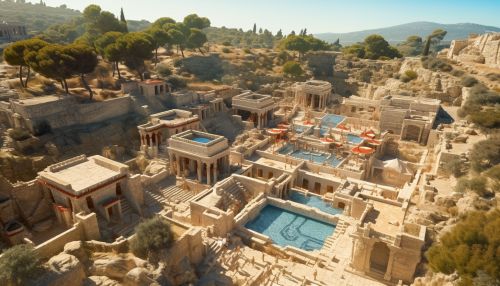Knossos
Overview
Knossos is an ancient city located on the island of Crete, which is the largest island in Greece. It is the site of the most important and best known palace of Minoan civilization. The city was inhabited for several thousand years, from the Neolithic period until the foundation of the first palace in the Early Bronze Age.
History
The site of Knossos has had a very long history of human habitation, beginning with the founding of the first Neolithic settlement c. 7000 BC. The city reached its peak during the Minoan period, when it was the center of power for the Minoan civilization.


Archaeological Discoveries
The first excavations at Knossos were conducted by Minos Kalokairinos, a Cretan merchant and antiquarian, in 1878. The most significant excavations were carried out by the British archaeologist Sir Arthur Evans, who uncovered the palace of Knossos in the early 20th century.
Architecture
The architecture of Knossos is characterized by its complex layout and the use of sophisticated construction techniques. The palace is known for its elaborate frescoes, which depict scenes from Minoan life and mythology.
Culture
The culture of Knossos was heavily influenced by the Minoan civilization, which is known for its advanced art, architecture, and writing system. The Minoans were a maritime society, and their influence can be seen in the maritime themes that are prevalent in the art and culture of Knossos.
Decline
The decline of Knossos began in the Late Bronze Age, when the city was destroyed by a series of natural disasters. The palace was abandoned and the city's population declined significantly.
Legacy
Despite its decline, the city of Knossos has left a lasting legacy. It is considered one of the most important archaeological sites in the world, and its discoveries have greatly contributed to our understanding of the Minoan civilization.
